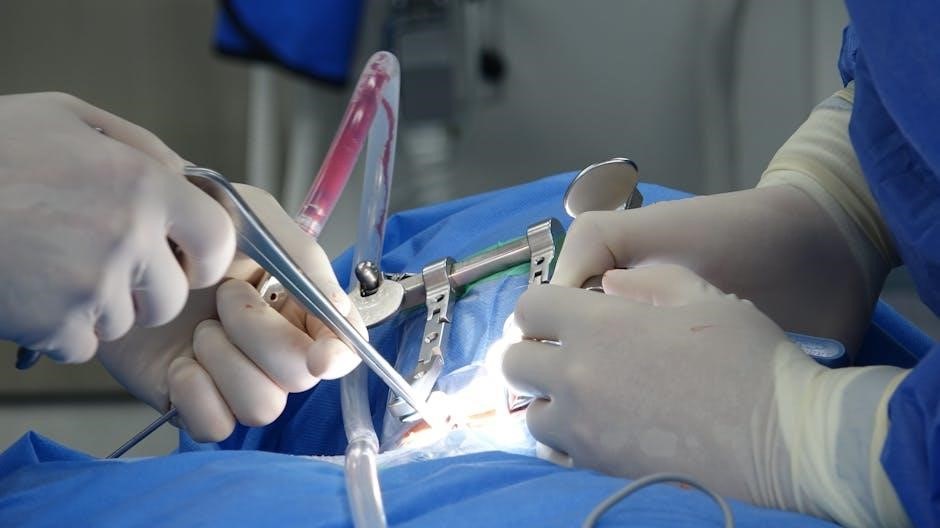Exercises after back surgery pdf are essential for recovery, with gentle stretching and strengthening of trunk and leg muscles, using
- ordered lists
to guide patients through exercises.
Importance of Post-Operative Exercises
Post-operative exercises are crucial for a successful recovery after back surgery, as they help prevent complications and promote healing. Using exercises after back surgery pdf, patients can follow a guided program to improve their flexibility and strength. The importance of post-operative exercises lies in their ability to enhance the recovery process, reducing the risk of infection and blood clots. By incorporating exercises into their daily routine, patients can regain their mobility and independence, allowing them to return to their normal activities sooner. A well-structured exercise program can also help manage pain and discomfort, making it an essential component of post-operative care. With the help of exercises after back surgery pdf, patients can take an active role in their recovery, ensuring a smoother and more effective healing process. This, in turn, can lead to better overall outcomes and a faster return to normal life.

Types of Exercises Recommended
Exercises include gentle stretching, strengthening, and
- unordered lists
of movements to promote flexibility and healing, using exercises after back surgery pdf guidelines carefully.
Deep Breathing Exercises for Recovery
Deep breathing exercises are essential for recovery after back surgery, and can be found in exercises after back surgery pdf guides. These exercises help to promote relaxation and reduce stress, which can aid in the healing process. By taking slow, deep breaths in through the nose and out through the mouth, patients can help to calm their mind and body. This can be especially helpful after surgery, when patients may be feeling anxious or uncomfortable. Deep breathing exercises can also help to improve lung function and reduce the risk of complications, such as pneumonia or other respiratory problems. Patients can find detailed instructions for deep breathing exercises in exercises after back surgery pdf resources, and can practice them regularly to support their recovery. Using
- unordered lists
and
- ordered lists
can also help patients to stay organized and focused.
Exercises to be Done Throughout the Day
Exercises after back surgery pdf include daily activities using links to guide patients through routines.
Preparation for Increased Activity
Exercises after back surgery pdf are designed to prepare patients for increased activity, with a focus on gentle stretching and strengthening of trunk and leg muscles, using
- ordered lists
to guide patients through exercises, and
- unordered lists
to provide additional tips and reminders, including information on how to avoid gym activities until advised by surgeon or physiotherapist, and how to incorporate daily activities into their routine, with the goal of promoting flexibility and increasing core activity, and ultimately returning to normal activities, with patients able to perform exercises within 2-4 weeks after surgery, and being fully healed within 3-12 months, depending on the type of surgery undergone, and the individual’s progress, with exercises playing a crucial role in the recovery process.

Benefits of Exercises After Surgery
Exercises after surgery promote healing, prevent weakness, and enhance recovery processes naturally.
Preventing Weakness and Promoting Healing
Exercises after back surgery pdf play a crucial role in preventing weakness and promoting healing by improving blood circulation and reducing muscle atrophy. Regular exercise helps to stimulate the growth of new tissues and cells, which is essential for the healing process. Using
- unordered lists
of exercises, patients can follow a structured program to strengthen their muscles and prevent weakness. This can include exercises such as gentle stretching, strengthening, and aerobic activities. By incorporating these exercises into their daily routine, patients can promote healing, reduce the risk of complications, and improve their overall quality of life. Additionally, exercises can help to reduce pain and inflammation, making it easier for patients to recover from back surgery and return to their normal activities. With a focus on prevention and promotion of healing, exercises after back surgery pdf are an essential component of the recovery process.

Timeline for Recovery and Exercise
Recovery and exercise timeline is typically 3-12 months using
to track progress and guide patients.
Returning to Normal Activities After Surgery
Returning to normal activities after surgery is a gradual process, with patients typically resuming daily activities within 2-4 weeks. This is achieved through a combination of exercises and physical therapy, with the goal of restoring strength and flexibility to the affected area. Using
- unordered lists
, patients can track their progress and stay motivated throughout the recovery process. A well-structured exercise plan, including activities such as walking and stretching, can help patients regain their independence and return to their normal routine. By following a personalized exercise program, patients can minimize the risk of complications and ensure a smooth transition back to their normal activities, with the ultimate goal of achieving a full recovery and returning to their pre-surgery lifestyle, using span elements to emphasize key points.

Patient Education and Rehabilitation
Patient education is crucial, using anchor tags to provide resources and guidance for rehabilitation, enhancing recovery and overall well-being, with proper exercise and care instructions.
Enhanced Recovery After Surgery and Activities of Daily Living
Enhanced recovery after surgery, also known as ERAS, is a program designed to help patients recover quickly and safely from surgery, using
- unordered lists
to outline activities of daily living. This program includes a combination of evidence-based practices, such as pain management, nutrition, and physical therapy, to help patients achieve optimal outcomes. By following ERAS protocols, patients can reduce their risk of complications, shorten their hospital stay, and improve their overall quality of life. The program also emphasizes the importance of patient education and empowerment, providing patients with the knowledge and skills they need to take an active role in their recovery, and using anchor tags to access additional resources and support. With ERAS, patients can expect a more streamlined and effective recovery process, and can get back to their normal activities more quickly.
and Future Work
Consistent and Patient-Centred Approach to Recovery
A consistent and patient-centred approach to recovery is crucial for effective rehabilitation, using structured exercise programs and
- ordered lists
to guide patients through exercises, with a focus on individual needs and goals, and incorporating patient education and support to promote adherence and optimal outcomes, and utilizing
to track progress and adjust treatment plans as needed, ultimately leading to improved patient satisfaction and reduced complications, with the use of
- unordered lists
to outline key principles and best practices for healthcare providers, and emphasizing the importance of
clear communication
and collaboration between patients, families, and healthcare teams to ensure a smooth and successful recovery process, with ongoing evaluation and refinement of treatment approaches to optimize results and improve patient outcomes.